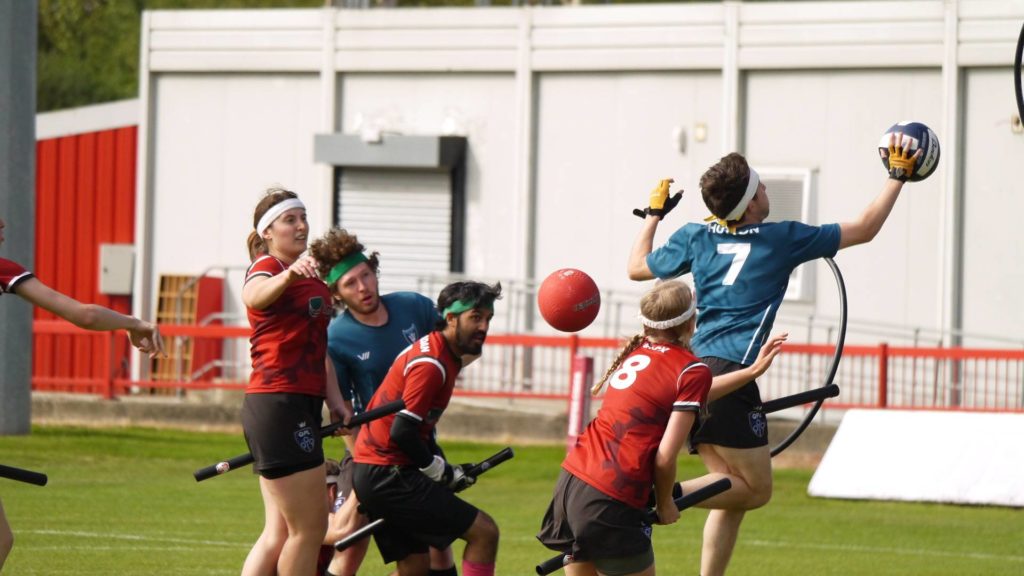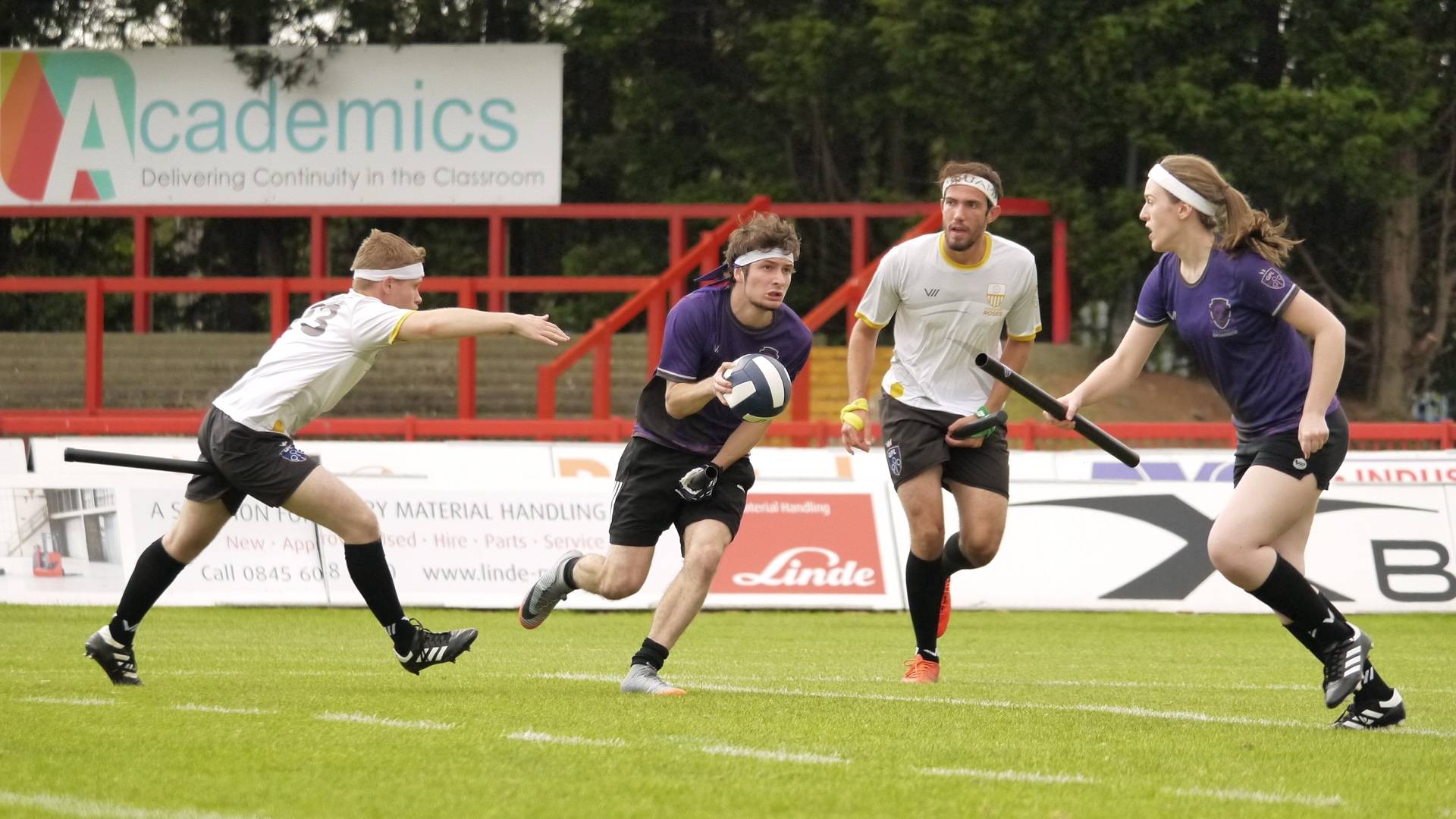Room on
the broom
The sport of quidditch has evolved beyond recognition from its fantastical beginnings in the Harry Potter books, but JK Rowling’s core message of acceptance and tolerance remains
I have a broom-handle between my legs, which I’m struggling not to drop while dashing around a pitch, trying to avoid being struck by a dodgeball. Curious bystanders stop in their tracks. Some even take photos. Understandable, as quidditch – the real-life version of the fictional sport from Harry Potter – is a surreal sight.
“We’ve moved on from 2005 when people wore capes and waved red and yellow wands.”
Like 20 or so other muggles here today, I’m at the tryouts for the Yorkshire Roses, one of ten regional teams that compete in the Quidditch Premier League, which was set up in the UK in 2016, running from May to August. It’s a bitterly cold Saturday afternoon in a boggy park near the University of Leeds when I’m given a crash course in the wizard sport. As he grabs his gumshield and smears stripes of mud over his cheeks, Joe Croucher – vice captain of the Leeds Griffins, one of around 50 university and community teams operating in the UK – jokes: “When the war-paint comes out, bodies will fall!” I’m about to experience quidditch in action – (Hog)warts-and-all.
“Everybody always wants to know about the brooms,” says Kim Spijkers-Shaw, 20, who also plays for the Leeds Griffins and is supporting those trying out from the sidelines. In JK Rowling’s books, Harry Potter and his magical muckers levitate around on broomsticks. Obviously humans can’t fly, but the general effect is replicated by the players hobby-horsing around on brooms, which are actually lengths of PVC piping – bristles having long ago been deemed impractical for a full-contact sport.
“But the broom is no more unusual than how you can’t move with the netball or how you can only catch the ball with one hand in water polo,” she argues. “It’s just the handicap that adds the challenge to the sport.”
Effectively, quidditch is three mini-games running concurrently – rugby, dodgeball, and the snitch game. Each squad has 21 players, with seven at a time on the field. There’s a keeper who guards the hoops; three chasers (think of them as the strikers) whose job it is to throw the quaffle (a semi-deflated volleyball) through the hoops to score 10 points; two beaters (essentially the defence) who hurl bludgers (dodgeballs) at the opposing players to temporarily disable them from play; and one seeker whose task is to catch the golden snitch when they arrive on the pitch 18 minutes into the match.
In Rowling’s source material, the golden snitch was a small flying ball with wings. Here it’s an impartial official dressed in yellow with a tennis ball inside a long sock hanging tail-like out of the back of their shorts. The game ends once the snitch is caught by one of the seekers, awarding that team 30 points.
“It adds a weird dimension to the game,” notes Croucher, today’s snitch. “The key is to be 40 points ahead because one team could be completely dominating the game and then manage to lose – because the other team practice with the snitch more often.”
Created in 2005 at Middlebury College in Vermont by two students, Xander Manshel and Alex Benepe, muggle quidditch is a global phenomenon, boasting a biannual World Cup – last won by Australia in 2016 – and featuring 25 countries, including South Korea, Pakistan and Uganda. The Quidditch Premier League has even been endorsed by Rowling herself, and was last won by the West Midlands Revolution, who beat the Southeast Knights at a final held at Craven Park Stadium in Hull last year.
Despite his boundless enthusiasm now, Jack Lennard – director of the Quidditch Premier League – approached trying the sport as a fresher at Oxford University in 2013 with natural scepticism. “Honestly, I expected a lot of idiots wearing cloaks – and it wasn’t that at all,” says the 22 year old. “I think I was one of the last wave of people to get involved because I was a massive Harry Potter fan. Now players are largely sports people who are disenchanted with traditional sports.”
There are no capes or scarfs today, nor is anyone cosplaying Draco Malfoy. Instead, players are resplendent in the full-strip for the team they usually play for, with their names emblazoned over the back, while coloured headbands denote their position. It’s all highly professional, but then competition is fierce. Out of 42 players cherry-picked for the Yorkshire Roses’ two selection dates, only 25 will make the cut – there’s even a bleep test and gauntlet run featuring endless burpees and push-ups to gauge fitness levels.
Here’s the unusual thing. Although the game has its roots in fantasy, it’s helping millennials grapple with the reality of 21st century issues. Lennard is genderfluid, and discovered his identity through quidditch. The core message of acceptance and tolerance in Rowling’s books has filtered down to create a refreshingly progressive sport. Teams are mixed, with each allowed a maximum of four players (the seeker notwithstanding) which identify as the same gender in active play. And, unlike some sports, a large proportion of players are LGBTQ.

“A lot of people say, ‘What have you kept from the Harry Potter books?’,” says Lennard. “We’ve moved a long way from the first rule book of 2005 where people did wear capes and instead of red and yellow cards, there were red and yellow wands. Now it’s evolved into its own thing, but I like to think we’ve kept the spirit of those books and the values they teach.”
As unique as playing a sport from Harry Potter is, he feels the “real USP” is that it’s the only mandated full-contact mixed-gender sport – with a ratio on the pitch that has to be met. “It’s the only one that accepts non-binary players,” he adds. “Trans players can play as whatever gender they identify as, whereas in other sports, you have to go through rigorous sex and hormone testing. That puts people off sport because it’s incredibly invasive and insensitive but here’s a sport where you can be respected for who you are.”
That was one of the appeals for Robin Agar – trying out today – an 18 year old from the University of Central Lancashire, who plays for the Preston Poltergeists. A self-confessed Potterhead, he’s biologically female but identifies as male. “It’s difficult to find a sport without toxic masculinity but everybody’s so accepting. In a lot of sports, it’s awkward being trans. If I do football, I feel like people are judging me. But here, in the team huddle beforehand, we’ll introduce ourselves with our preferred pronouns – like ‘I’m Robin, he/him’ – and nobody bats an eyelid.”
A female player quips that quidditch is probably the only situation where a man telling a woman to “Grab a broom!” is actually empowering.
Joshua Fogg – manager of the Yorkshire Roses – says the genders are evenly matched. “Because you’re only allowed to initiate tackles with one arm, rather than it being the strongest person knocking over the other, you’ll see women take people down twice their size because it’s more about technique”, elaborates the 21 year old.
Elliott “Fish” Fisher is a keeper for Team UK’s expansion squad and had played rugby at a professional level before being injured at university. “I’m regularly floored by female players half my size,” he explains, as he watches his girlfriend try out for the Yorkshire Roses. “Compare this to female rugby where it isn’t as well-funded and the talent isn’t as encouraged as in male rugby. With quidditch, it’s the opposite. Female players are absolutely dominating.”
There’s roughly a 50/50 split between Potterheads and those who simply like quidditch and are indifferent towards its original inspiration. Bizarrely, “there’s even a whole group now who want the sport renamed and to completely disassociate from Harry Potter,” says Croucher, who initially only agreed to attend his first training session as a penance to a friend he’d spilled a drink on during freshers’ week. He was smitten, and three years later, the 22 year old is still involved. “You get this weird mix. Some of the best players in the country couldn’t even tell you who Ron Weasley is, but then there are others who could tell you [what’s on] page two, word four.”
Many here echo the sentiments of Fogg when he observes: “I came for the Harry Potter – and stayed for the sport. You don’t expect it to be as intensive as it is.”
The welcoming community also appeals. The atmosphere is definitely more Hufflepuff than Slytherin. Everybody is relentlessly positive and supportive; nobody quidbitches. “You’ll never meet a nasty quidditch player,” says 19-year-old Julian Buckley, who plays for the Liverpuddly Cannons. “The testosterone from a lot of sports can detract from the socialising.”
This love-fest means it’s a good way to encourage people who were scarred by school PE lessons back into team sports – particularly the one in seven LGBT pupils bullied during sports lessons, according to the latest Stonewall figures. There’s even a non-contact kids’ version with its own rulebook that Lennard and co are keen to see rolled out into schools.
A campaign to get quidditch Sport England-recognised is underway, which would mean benefits such as the ability to apply for government grants and National Lottery funding. But is it really a bona fide sport as opposed to a collegiate novelty? Certainly, it has the strategy and athleticism you’d encounter in more orthodox sports. In his team talk, Croucher assesses the opposing team’s strengths and weaknesses with John Motson-levels of forensic detail, before “BROOMS UP!” is called, and the players sprint towards the bludgers and quaffle. It’s unusual to watch – though no more so than curling or canoe-polo – and with the high risk of injury involved, it brings new meaning to the old prison mantra of “snitches get stitches”.
“I grew up in a rugby background and my parents were initially embarrassed by this,” recalls Fisher. “But then they came and watched it and fell completely in love with it. When you watch the high-level teams, it’s thrillingly impressive and you start to realise the level of tactics involved.”
“The thing is,” adds Spijkers-Shaw, “you have people mocking it and thinking it looks silly with the brooms. Then they try it and within two minutes, they’re thrown on the floor and realise it’s an actual sport.”
I can attest. In the beater drill, the idea is to avoid being hit by the bludger. One player skilfully scissor-kicks over it; another sneakily dives between his opponents’ legs. My approach? Standing stock-still while it – doof! – kersplats in my face, leaving me muddier than Katie Hopkins’ name. Despite any initial cynicism I might have harboured about the skill involved, I’m leaving with my tail, rather than a broom, between my legs.
Main image: Yorkshire Rose (white) vs Southwest Broadside (purple) in the Quidditch Premier League (Jessica Cornelius/ Quidditch Premier League)
This article has been amended to say that Elliot Fisher is a keeper for Team UK’s expansion squad but did not play in the World Cup or European Games.

Leave a reply
Your email address will not be published.